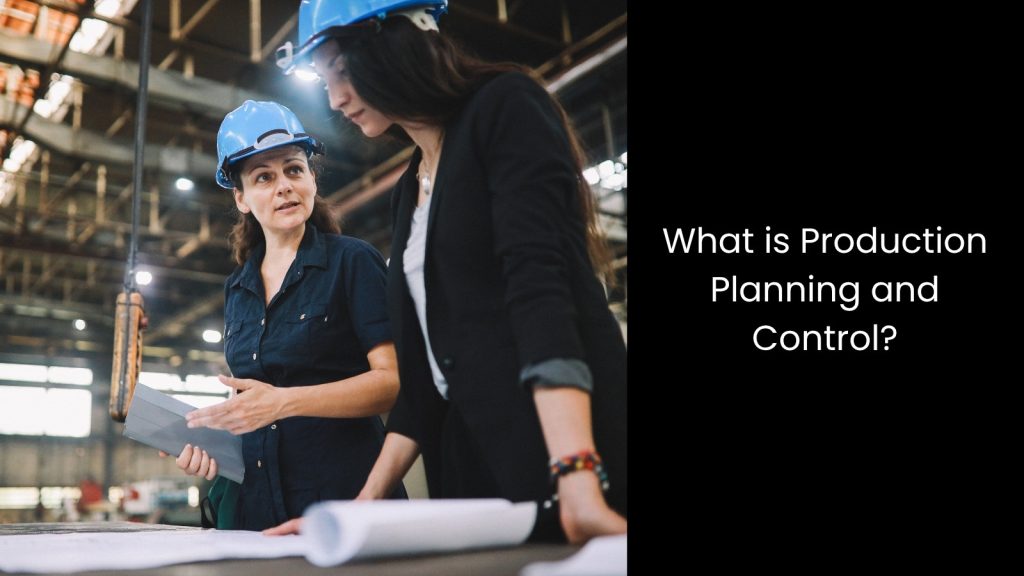This article explores the fundamental roles these functions play, outlining the key stages involved and the benefits they bring.
We will look into
- What is Production Planning and Control?
- Why Production Planning and Control Matters in Manufacturing
- Key Objectives of Production Planning and Control
- The 8 Main Steps of Production Planning and Control
- Cerexio Production Order Management System for Full Production Control
- Future-Proofing Your Production with Digital Solutions
What is Production Planning and Control?

- This means managing every step of making a product, from getting materials to scheduling tasks and making sure everything runs smoothly on the factory floor.
- It includes two important parts: production planning, where teams decide what to make, when to make it, and how much to make, and production control, where they follow up on those plans and keep everything on track.
- In this fast-paced world of manufacturing operations, businesses need to stay organised and flexible. That is where this process steps in.
- It helps teams plan resources, reduce delays, and fix problems before they get worse. So, what is the real goal?
- Keep production smooth, cost-effective, and ready to meet demand without wasting time or materials. It connects people, machines, and schedules into one smart system.
Why Production Planning and Control Matters in Manufacturing

- The latter matters in manufacturing as it connects the manufacturing strategy with daily work on the factory floor. When teams plan and control production properly, they match business goals with smart production workflows that make sense.
- This smooth flow helps companies run faster and smarter, not harder.
- It also keeps the supply chain steady because teams know what to make, when to make it, and what they need to make it happen. That kind of structure cuts down delays, stops waste, and saves money. It also makes it easier to keep promises, like sending products out on time and meeting customer expectations.
- As the process keeps moving, manufacturers stay on top of quality control too, catching problems before they grow. Good planning boosts operational efficiency and makes sure workers and machines do not sit around waiting.
Key Objectives of Production Planning and Control

Maximising Utilisation of Manpower, Machinery, and Materials
It always focuses on using resources in the smartest way. Manufacturers can plan the workflow so workers stay active, machines keep running, and materials do not sit around wasted. This goal helps factories hit their production targets while meeting important manufacturing KPIs that track resource usage in lean manufacturing.
Minimising Production Downtime and Waste
Planners can carefully schedule every step to stop delays and cut down on scrap. They can solve problems before they slow things down. This approach keeps machines working smoothly and avoids extra costs. It also helps teams stay on track with production targets and meet manufacturing KPIs focused on efficiency and lean manufacturing goals.
Ensuring Consistent Quality and Timely Output
Industrialists can keep everything in order so the final products meet the same high standards every time. They set timelines and check progress daily. This clear process helps teams finish tasks on time and meet strict manufacturing KPIs. It also supports lean manufacturing by reducing rework and reaching the right production targets.
Core Benefits of Effective Production Planning and Control

Enhanced Inventory Management and Procurement Accuracy
This smart inventory control keeps shelves balanced and costs steady. When production teams follow real-time updates, they make better buying choices and reduce mistakes.
This organised method cuts waste, saves space, and supports lean production. As a result, the whole system runs smoother. Manufacturers will avoid last-minute panic orders and focus on hitting production goals with better accuracy in both planning and procurement processes.
Reduced Lead Time and Faster Turnaround
A shorter lead time means companies deliver products sooner and earn customer trust. Teams that follow a clear production plan reduce confusion and avoid bottlenecks. They know what comes next, and they finish tasks without waiting around.
This kind of process efficiency supports faster turnaround times. With strong planning, everyone moves in sync, from machine operators to packers. Everything flows better, and the company gains a strong edge in speed without rushing or skipping steps.
Lowered Production Costs and Minimised Waste
They avoid piling up products no one ordered, and that lowers extra costs. Careful scheduling also helps reduce energy use and machine wear. These small savings add up fast and create real cost reduction across the board.
Every worker understands their task, so they waste less time figuring things out. This sharp focus lowers errors and boosts performance.
Improved Coordination among Departments and Vendors
When departments talk to each other and share needs early, nothing slips through the cracks. Smooth supplier coordination means vendors know what to deliver and when, helping prevent delays. This teamwork supports better process efficiency, which helps production flow without interruption.
Teams inside the company also stay connected and avoid confusion. With clear roles and timelines, everyone stays aligned from start to finish, which keeps production goals on track.
The 8 Main Steps of Production Planning and Control

- Planning – This is where manufacturers set goals, pick the right materials, and map realistic timelines. This planning stage launches manufacturing planning stages, guides each production process step, and creates firm workflow control that keeps resources tight, schedules honest, and workers motivated.
- Routing – Routing sketches the journey from raw stock to finished goods, choosing machines and workstations with care. This is where teams secure handoffs, sharpen workflow control, strengthen production process steps within manufacturing planning stages, trim confusion and boost output.
- Scheduling – This step lines up tasks by priority and time, fitting work orders into calendars. Managers balance capacity, guard workflow control, and push manufacturing planning stages forward until each production process step fires at the right moment.
- Loading – Loading spreads machine hours and labour smartly without overdoing any station. Planners read capacity charts, assign crews wisely, keep queues fair, secure workflow control through manufacturing planning stages and production process steps, and prevent overload downtime.
- Dispatching – This step springs tasks into action, issuing work orders, drawings, and material lists. In this stage, supervisors brief operators, release tools, and ignite momentum, ensuring manufacturing planning stages translate into production process steps under workflow control that keeps everyone ready.
- Expediting – The expediting stage tracks progress in real time, spots delays, and kicks obstacles aside. In the meantime, coordinators adjust schedules, reroute parts, and protect workflow control, pushing manufacturing planning stages forward so every production process step finishes on time and customers smile.
- Inspection – In this step, manufacturers check parts and finished goods against quality rules while technicians measure sizes, test function, log numbers, and guard trust, reinforcing manufacturing planning stages. They tighten workflow control and confirm each production process step meets standards before shipping.
- Correction – This stage closes the loop, studying reports, spotting gaps, and changing methods. This is where the managers tweak machines, retrain staff, refresh instructions, lift workflow control, and strengthen future manufacturing planning stages so upcoming production process steps run even smoother, faster, and cleaner.
Cerexio Production Order Management System for Full Production Control

Cerexio Production Order Management System supports full production control by streamlining job orders, tracking real-time progress, and aligning tasks with resources. Our system boosts efficiency across all production process steps, enhances workflow control, and connects seamlessly with manufacturing planning stages for better visibility, faster decisions, and smarter execution from start to finish.
Future-Proofing Your Production with Digital Solutions

Digital tools transform production by improving inventory control, reducing lead times, and enhancing process efficiency. Integrating these solutions with strong manufacturing planning stages empowers companies to stay agile, lower waste, and maintain steady growth, ensuring they remain competitive as industry demands evolve.
